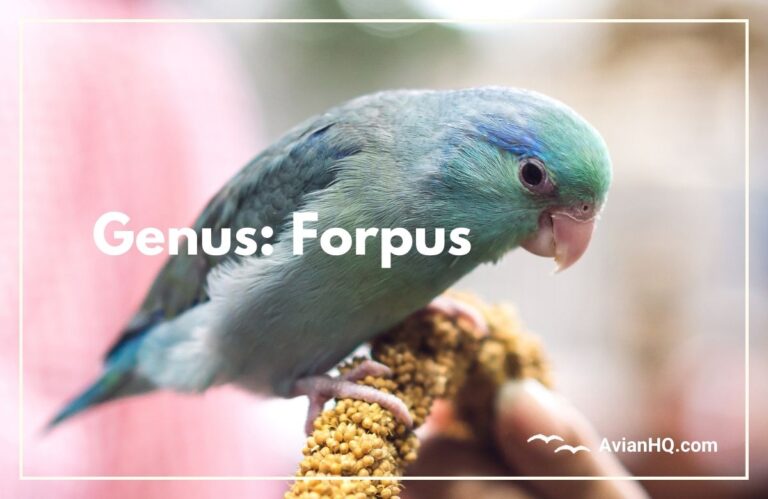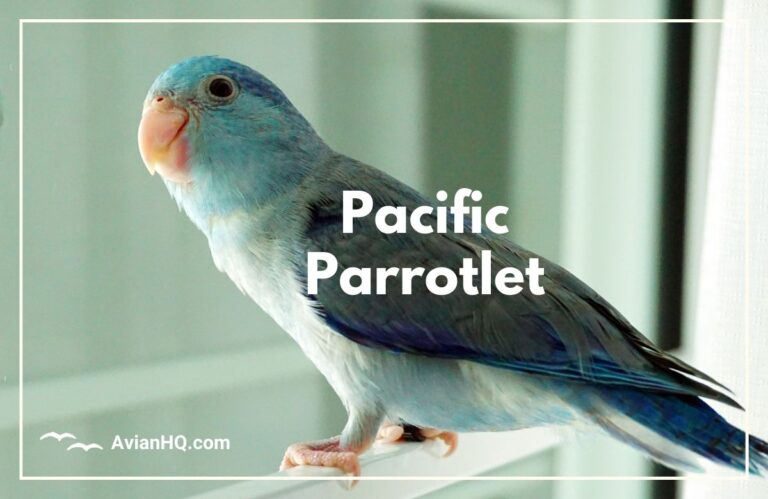Mexican Parrotlet (Forpus cyanopygius)
The Mexican Parrotlet (Forpus cyanopygius) is one of the smallest parrots in the world, but what it lacks in size it makes up for in color and personality. As their name suggests, these tiny parakeets are native to Mexico, inhabiting arid forests and scrublands primarily along the country’s western coastal region.
You could cup one of these vibrant birds in the palm of your hand – Mexican Parrotlets reach just 3 to 4 inches (8 to 10 cm) in length and weigh a mere 0.6 to 0.9 ounces (18 to 26 grams). But their plumage packs a visual punch, with their backs and wings decked out in emerald, lime, and olive hues, offset by royal blue flight feathers. Their tails and lower bodies shine with brighter cyan tones, males sporting more vibrant turquoise than the females. A splash of yellow and orange finishes the look on their fronts.
Despite occupying restricted arid habitats under increasing pressure from development and climate change, Mexican Parrotlets have adapted through their social smarts and flexibility. They gather in large flocks made up of multiple pairs that work cooperatively to find food and nest sites. By banding together, these tiny parrots can take advantage of seasonal bumps in food availability and overcome shortages. This has allowed them to make use of both natural and human-altered environments.
As Mexico’s sole endemic parrot species, the Mexican Parrotlet is a national treasure and source of pride. Its bright colors and spunky attitude have also made it an increasingly popular pet internationally. However, laws restrict legal trade in wild-caught birds, meaning captive birds are often bred from smuggled stock. Their specialized habitat needs and small range continue to pose conservation concerns.
This article will explore the unique traits of the Mexican Parrotlet both in the wild and captivity – from its taxonomic background and physical features to behavioral quirks, conservation efforts, and cultural significance for Mexico. Despite its tiny frame, the Mexican Parrotlet has big appeal, making it a species worthy of attention.
History and Taxonomy
The Mexican Parrotlet was first described scientifically in 1856 by the French ornithologist Charles Lucien Bonaparte, based on specimens collected in Mexico. He placed the bird in the genus Forpus, deriving its species name cyanopygius from the Ancient Greek words “kyanos” meaning blue and “pyge” meaning rump or tail. This reflects the bird’s distinctive bright blue rump patch.
For a time the Mexican Parrotlet was considered to be the same species as the Pacific Parrotlet of Ecuador and Peru until they were recognized as separate in 1911. Some experts further divided the Mexican Parrotlet into up to five subspecies based on minor variations in size and color between different geographic populations. However, most current authorities recognize it as a single species (Forpus cyanopygius) with no differentiated subspecies.
Within the Forpus genus, molecular studies have confirmed the Mexican Parrotlet’s closest relatives to be other Central American Forpus species, particularly the Yellow-faced Parrotlet (Forpus xanthops) of Panama. There has been debate about classifying these smaller American parrotlets within their own Parvorder Forpidea separate from other parrots, but lack of supporting evidence means they remain within the true parrot clade Psittaciformes.
So while tiny in stature, the Mexican Parrotlet has a well-established taxonomic history recognizing it as a distinct Neotropical parrot species endemic to Mexico’s arid Pacific coast. Ongoing research helps solidify its evolutionary relationships to neighboring parrotlet relatives.
Physical Appearance
The Mexican Parrotlet is diminutive even among parrot standards, though its vibrant plumage packs visual punch. They reach 3 to 4 inches (8 to 10 cm) long and weigh just 0.6 to 0.9 ounces (18 to 26 grams) with a wingspan around 5.5 to 6 inches (14 to 15 cm).
Their backs and wings show bright shades of green, ranging from emerald to lime, set off by deep blue flight feathers. The upper tail coverts and tail feathers are a striking cyan blue, more intense on the males. The rump is also blue. The breast and belly contain variable yellow and orange hues, sometimes forming a partial breast band. The flanks are more greenish. The head is mainly green with a yellowish forehead, bluish cheeks, and white eye rings. The curved bill is black, and legs gray.
Females are slightly duller overall with less vibrant plumage than males, especially on the rump and tail. But even juvenile birds show surprisingly mature coloration. Regional variations in shade intensity have led to some subspecies descriptions but most authorities currently recognize a single species without differentiated races.
This botanical palette of blue, green, yellow and orange makes the Mexican Parrotlet a diminutive work of art. Its markings distinguish it from the mostly green Pacific Parrotlet, its nearest relative. The complex coloration patterns help the highly social birds recognize flock members and choose mates while standing out against the arid backgrounds they inhabit.
Habitat and Distribution
The Mexican Parrotlet resides in just a small stretch of Mexico’s western coastal region where arid tropical forests and scrublands dominate. Its range extends about 310 miles (500 km) along the Pacific coast from southern Sonora state to Guerrero. Mostly found at lower elevations up to 3,000 feet (914 meters), sightings occasionally occur as high as 5,900 feet (1,800 meters).
These tiny parrots stick to dry forest ecosystems and deciduous woodland habitats where they can nest in tree cavities. This includes tropical dry forests, thorn scrub forest, and arid subtropical scrublands. They seem to prefer areas with a mix of larger trees, adjoining open spaces, and access to water sources. Palo verde, mesquite, acacia and other dry-climate trees make up regular habitat. Mangroves are also occupied seasonally when food is abundant.
The largest populations center around inland valleys and foothills of southwestern Jalisco state near Chamela-Cuixmala and in coastal Michoacán. Isolated groups and sporadic sightings confirm their presence elsewhere in smaller pockets of suitable habitat between Sonora and Guerrero. But the total species population likely numbers only in the low thousands.
Accelerated deforestation for agriculture and development continues to drive extensive habitat loss and fragmentation throughout the tiny parrot’s restricted range. Its survival depends on conserving patches of existing native dry forest ecosystems. Closely monitoring known key breeding areas combined with public outreach can help safeguard Mexico’s rare endemic parrot.
Diet and Feeding
The Mexican Parrotlet’s small size means it must eat frequently to meet its high metabolism, consuming about a third of its body weight in food each day. Their natural diet consists of seeds, fruits, berries, buds, nuts and occasional insects.
This parrot is well adapted to take advantage of ephemeral fruitings in neotropical dry forests during the rainy season. Flocks forage acrobatically through trees to access fruit and seed pods. Foods include figs, mangos, tamarind and pods from mesquite, palo verde and other local species.
In the dry months when less fruit is available, parrotlets rely more on the nectar and pollen from blooming succulents like cacti and agaves. Some seasonal and directional movements are driven by tracking the best food sources across their range.
Captive diets aim to replicate the diversity of native foods. A quality parrotlet mix can form a dietary base supplemented with vegetables, sprouted seeds, healthy grains and limited fruit. Despite their small size, captive parrotlets are energetic, inquisitive birds that need both physical and mental enrichment. Rotating toys, training, foraging activities prevents boredom from setting in. Offering native food plants lets pet birds engage in natural foraging behaviors.
With proper nutrition and care, Mexican Parrotlets in captivity can live 8 years or longer, considerably more than their 3-4 year average lifespans in the wild. Monitoring food intake ensures pet birds maintain healthy weights even through molting periods or raised activity levels during breeding condition. The species’ specialized arid forest diet makes providing variety to captive individuals important for wellbeing.
Breeding and Reproduction
Mexican Parrotlets reach sexual maturity once around a year old and form monogamous breeding pairs that can last multiple seasons. Though solitary nesting occurs, they more often reproduce colonially with multiple pairs nesting closely together.
The breeding season falls between March and June timed with the start of the rainy season and ensuing burst in food resources. Peak egg laying activity happens April-May. This synchronizes maximum chick rearing with seasonal food abundance in their arid habitat.
Nest sites are holes or cavities excavated by the birds themselves or existing hollows found in columnar cacti, agave stalks, arboreal termite nests, and most often, dead trees. Both males and females select the nest site and work together excavating the hole, though the female takes the lead shaping the inner cavity. Surrounding colonies help defend chosen nest trees from predators.
Typical clutch size is 4-6 tiny white eggs though 3-9 can occur. Only the female incubates the eggs for about 23-25 days until hatching. Chicks fledge around 5-6 weeks old but may remain with and be fed by the parents an additional 2-3 weeks as they perfect flight skills.
In captivity, providing suitable enclosed nest boxes encourages breeding. Care must be taken though to ensure parents receive ample nutrition, or else they may abandon eggs or sacrifice young if insufficient food sources are available to support the brood. As highly social parrots, interaction with a colony group also aids stimulating breeding condition. Achieving consistent captive reproduction helps satisfy market demand while reducing pressures on wild populations.
Behavior and Ecology
Mexican Parrotlets exhibit highly social behaviors, gathering in large flocks of 10 to 30 or more birds that roam together searching for food sources and roost sites. The flocks often contain multiple mated pairs and family groups rather than just solitary individuals.
Their days begin just after sunrise with morning vocal sessions of chattering and contact calls between flock members. Later mornings are spent actively foraging and feeding before returning to roost trees midday to preen and rest during hottest hours. Late afternoons bring another period of activity and socializing before settling into communal roost cavities or nests for the night.
Roosting and nesting in dense colonies provides security from predators like birds of prey, snakes, and raptors which pose the main threats. During the day, shifting subgroups break off for foraging then reunite later to share information on feeding hotspots. Flocks are very vocal, using a repertoire of chirping calls and chatters to maintain contact.
Pairs may break off from flocks during breeding but regularly interact with colony members. The bright plumage and active flocking are believed to help fleeing birds confuse predators. This safety in numbers and cooperation between breeding pairs allows them to take advantage of temporary food bonanzas in their harsh seasonal habitats.
These behaviors make the Mexican Parrotlet a highly adaptable species able to exploit both undisturbed and marginal altered habitats. Their flexibility likely contributes to the species’ relative success compared to other endemic Mexican parrots. Fostering protection of known active nesting colonies will be key to ensuring that success continues in the face of ongoing threats.
Conservation Status
The Mexican Parrotlet is considered a species of least concern by the IUCN Red List. However, its small endemic population estimated between 1,000 – 10,000 mature individuals faces threats from habitat loss and collection for the pet trade.
The parrotlet’s restricted range coincides with a zone of southwest Mexico experiencing severe deforestation pressures. Expanding agriculture, cattle ranching, and development have caused extensive clearing and degradation of native dry forest ecosystems. This fragments and isolates remaining arid habitat.
Excessive collection for the caged bird market is another concern though Mexico banned export of wild-caught parrots in 2008. Persistent illegal trapping likely occurs but is unquantified. Most commercial trade now derives from captive breeding of smuggled birds. This at least takes pressure off wild populations.
Protected areas across parts of the species’ range provide some sanctuary pockets but coverage remains limited. Further habitat conservation aimed at preserving intact patches of tropical dry and deciduous forest will benefit survival odds. Continued ecosystem degradation could negatively impact food supplies or nesting capacity.
While still reasonably abundant, the Mexican Parrotlet’s limited numbers and distribution merit ongoing monitoring and habitat protection efforts. Preserving sufficient habitat connectivity allows seasonal movements key to tracking variable food resources across their arid forest ecosystems. As Mexico’s sole endemic parrot, conserving the species should remain a conservation priority.
Cultural Significance
Its vibrant colors and lively personality have made the Mexican Parrotlet popular in the caged bird trade internationally. Their small size suits apartment living yet they remain active and vocal. Hand-reared babies socialize readily with human caretakers.
Selective captive breeding has generated color variants like blue, yellow, white, and cinnamon alongside the natural green and turquoise types. Their reproduction in captivity helps supply consumer demand. However, wild-caught specimens likely still enter illegal export channels despite trade bans.
Within Mexican culture, the parrotlet is celebrated as the nation’s only endemic parrot species lending it patriotic appeal. Its image has been used in logos for Chamela-Cuixmala Biosphere Reserve where populations occur. “Perico Mexicano” also inspired the name of a popular Mexican hot sauce brand.
The species’ specialized habitat preferences also make it an indicator of Mexico’s highly threatened tropical dry forests. Protecting intact ecosystems benefits many unique arid-adapted plants and animals. In this sense, conservation efforts aimed at the charismatic parrot serve to umbrella larger biodiversity interests.
Going forward, sound captive breeding can continue supplying parrotlets as pets without threatening remaining wild populations. But habitat preservation is still needed in protected reserves and surrounding buffer lands that sustain Mexico’s sole native parrot. Achieving both goals will secure the long-term survival of the species.
Conclusion
The Mexican Parrotlet stands out for being the sole parrot species endemic to Mexico. Its restricted range in diminishing Pacific coastal dry forests means it faces inherent risks, yet the birds reveal resilience thanks to their social habits and adaptability.
Flocks exhibit cooperative behaviors that allow them to take advantage of both pristine and degraded dry forest habitats. Their ability as cavity nesters to reproduce colonially offers security and helps maximize seasonal food supplies. This flexibility likely explains the success of the Mexican Parrotlet compared to other threatened endemic parrots in Mexico.
Conservation should focus on preserving connectivity and integrity of arid tropical forest ecosystems regionally to safeguard food, nesting, and roosting resources. Continued habitat loss and degradation pose the most significant long-term threats to populations already constrained in range and numbers.
Meanwhile, traditional demands for colorful pet parrotlets can be met sustainably through properly managed captive breeding rather than illegal trade in wild birds. This charismatic species has potential to draw attention as an emblem of Mexico’s highly endemic dry forests and their conservation needs.
Though tiny, weighing the same as a few coins, the Mexican Parrotlet has outsized importance. Ensuring the species persists offers wider benefits for regional biodiversity as well as national pride in Mexico’s only native parrot. With sound management, its bright plumage should continue to flourish across parts of coastal Mexico into the future.






